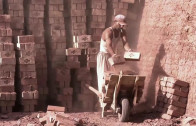Slavery — A 21st Century Evil
Far from ending with the abolition of slavery, the trade in human beings is thriving more than ever before. Today, 27 million men, women and children are held, sold and trafficked as slaves throughout the world. From the sex slaves of Eastern Europe to China’s prison labour slaves; from Brazil’s hellish charcoal slave camps to entire families enslaved in Pakistan’s brick kilns, this series exposes the people behind modern slavery and the companies who profit from it.
Series
Part one investigates food chain slavery–considered the easiest form of slavery to stamp out in the United States. The US claims to be leading the global fight against modern slavery, but according to conservative estimates, there are between 40,000 and 50,000 slaves in the United States alone today. Part one questions why a nation built on the abolition of slavery–a country that had to go through a painful civil war to formally bring an end to slavery–is failing to address the problem inside its own borders. The investigation begins in the poor villages of Thailand, where agents for the US slave masters trick desperate peasants with promises of well-paid jobs abroad. But far from fulfilling their American dream, many end up in slave labour farms in Hawaii, California and Florida–unable to return home and working to pay off the debts they incurred in the pursuit of a better life for themselves and their families.
There are an estimated 1.4 million sex slaves in the world today; most of them are women, and many thousands of children. These women do not voluntarily enter prostitution, but have been forced under the threat of violence to have sex with men who pay their ‘owners’. Sex slavery is present in every country of the world. In some cases, categorised as ‘domestic’, women are sold into brothels within their own country. But international sex trafficking of women and children is on the rise. Part two investigates the enslavement and trafficking of women from Moldova, the poorest country in Europe, to wealthier European countries, in particular to the red light district of Amsterdam, one of Europe’s most profitable sex markets and a major international tourist attraction.
Part three investigates slavery that is passed down from father to son, mother to daughter. Although the practice of bonded labour is common in several parts of the world, in Pakistan and India, the systematic enslavement of generations of workers is widespread as governments fail to enforce their own laws against bonded labour. This episode follows men, women and children labouring in quarries and brick kilns, in dangerous conditions and for effectively no pay. Most of these slaves have been held for generations, paying off a supposed ‘loan’ taken out by their grandparents. Some have been lucky enough to escape but others have had to buy their way out of it by selling their organs to help pay off the ‘debt’.
There are at least 8.4 million child slaves in the world today. Nearly two million of these are forced to work as prostitutes, while almost half a million are child soldiers. But the largest proportion of child slaves–more than five million–are held as forced labour. In some countries, these child slaves are simply juvenile victims of a thriving adult slave culture, but in other countries children are bought and sold specifically as child labourers. Part four focuses on the plight of child slaves in Haiti. They are known as ‘restaveks’ from the French words ‘rester avec’, meaning ‘to stay with’. This is the practice of poor families giving their children as domestic help to wealthier acquaintances or relatives. As well as taking place within Haiti, this form of slavery can also involve children being sold or trafficked to the United States.
Brazil, once the world’s largest importer of slaves from Africa, has taken the lead in fighting 21st century slavery with a raft of innovative laws aimed at stamping it out. However, slave labour continues to thrive in the South American country, especially in the age-old practice of charcoal burning. The dirty and dangerous business is relied on by many international companies as one of the early stages in the manufacturing of pig iron. Brazilian pig iron is shipped to some of the world’s biggest corporations such as General Motors and Ford who use it to forge steel. Charcoal burning is often carried out by forced labourers, including men from the poverty-stricken north of Brazil who are lured with false promises to remote camps. They are forced into working and living in appalling conditions, and often tricked into amassing massive debts that are impossible to meet in order to pay for their accommodation and even work equipment.
In the midst of widespread poverty, fueled by economic inequality and rampant corruption, a new form of slavery–bridal slavery–has flourished. Women and young girls are sold for as little as $120 to men who often burden them with strenuous labour and rape them. In a country where female children are sometimes considered a financial burden, the common practice of infanticide and gender-selective abortion has led to a shortfall in the number of women available for marriage–something made all the more problematic by high dowry costs, encouraging bride trafficking.
Once an isolationist communist state, over the last 20 years China has become the world’s biggest exporter of consumer goods. But behind this apparent success story is a dark secret–millions of men and women locked up in prisons and forced into intensive manual labour. China has the biggest penal colony in the world–a top secret network of more than 1,000 slave labour prisons and camps known collectively as “The Laogai”. And the use of the inmates of these prisons–in what some experts call “state sponsored slavery”–has been credited with contributing to the country’s economic boom. In this episode, former inmates, many of whom were imprisoned for political or religious dissidence without trial, recount their daily struggles and suffering in the “dark and bitter” factories where sleep was a privilege.




